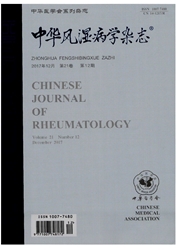

 中文摘要:
中文摘要:
目的检测多发性肌炎,皮肌炎患者血清可溶性人类白细胞抗原-G(sHLA-G)水平,并分析其与多发性肌炎,皮肌炎各临床特征及治疗和预后的关系,探讨血清sHLA-G在多发性肌炎,皮肌炎发病机制中的可能作用。方法利用酶联免疫吸附试验(ELISA)方法测定96例多发性肌炎,皮肌炎患者(其中多发性肌炎26例,皮肌炎70例)和35名健康体检者血清sHLA-G水平,分析血清sHLA-G与多发性肌炎,皮肌炎患者临床特征、实验室指标及治疗、预后的关系。结果血清sHLA-G水平在多发性肌炎,皮肌炎患者[(44±70)U/m1]明显高于健康对照者[(4±5)U/ml,P〈0.01)]。皮肌炎患者组血清sHLA-G水平[(54±81)U/m1]明显高于多发性肌炎患者组[(27±41)U/ml,P=0.004]。血清sHLA.G升高组多发性肌炎/皮肌炎患者中吞咽困难的发生率较sHLA-G正常组明显升高(P=0.001)。sHLA-G水平与CD3*T细胞和CD4+T细胞水平均呈负相关(r=-0.233,P=0.047;r=-0.287,P=0.015),与补体C3水平呈正相关(r=-0.284,P=0.021)。初治组患者血清sHLA-G水平[(77±99)U/m1显著高于经治组[(34±52)U/ml,P=-0.021]。但血清sHLA-G水平与疾病活动度无明显相关,糖皮质激素及免疫抑制剂治疗对血清sHLA-G水平也无明显影响。结论血清sHLA-G水平在多发性肌炎,皮肌炎患者中明显升高,并且与外周血CD3+和C134+T细胞数呈负相关,临床上与吞咽困难的发生相关,提示sHLA-G可能在多发性肌炎,皮肌炎病理过程中发挥一定作用。
 英文摘要:
英文摘要:
Objective To investigate the serum levels of soluble human leukocyte antigen (sHLA)-G in patients with polymyositis (PM) or dermatomyositis (DM), and to analyze its association with clinical features and possible role in the pathogenesis of PM/DM. Methods Serum sHLA-G levels of 26 patients with PM, 70 patients with DM and 35 matched healthy controls were measured by ELISA. The relationship between the sHLA-G levels and clinical features or seroimmunological data in the patients with PM/DM was analyzed. Results Serum levels of sHLA-G in PM/DM patients were significantly higher compared to healthy controls [ (44±70) U/ml vs (4±5) U/ml, P〈0.01 ]. There was statistically significant difference between DM patients and PM patients [(54±81) U/ml vs (27±41) U/ml, P=0.004]. The incidence of dysphagia was significantly higher in sHLA-G elevated group than those in sHLA-G normal group (P=0.001). Additionally, Spearman rank correlation analysis showed that the serum sHLA-G levels were positively correlated with serum C3 (r=0.284, P--O.021), but negatively correlated with CD3~ T cells (r=-0.233, P=0.047) and CD4+ T cells (r=--0.287, P=0.015) in the peripheral blood in patients with PM/DM. Serum levels of sHLA-G in non-treated PM/DM patients were significantly higher compared to treated patients [(77±99) U/ml vs (34±52) U/ml, P=0.021 ]. No relationship between serum sHLA-G levels and PM/DM disease activity, or different drug therapy was found. Conclusion Serum levels of sHLA-G are increased in PM/DM patients. The increased production of sHLA-G, paralleled with higher incidence of dysphagia and lower level of CD2+ T cells and CD4+ T cells, indicates that sHLA-G may play an important role in the pathogenesis of PM/DM.
 同期刊论文项目
同期刊论文项目
 同项目期刊论文
同项目期刊论文
 Clinical Characteristics of Anti-3-Hydroxy-3-Methylglutaryl Coenzyme A Reductase Antibodies in Chine
Clinical Characteristics of Anti-3-Hydroxy-3-Methylglutaryl Coenzyme A Reductase Antibodies in Chine Cyclophosphamide treatment for idiopathic inflammatory myopathies and related interstitial lung dise
Cyclophosphamide treatment for idiopathic inflammatory myopathies and related interstitial lung dise Expression of tumor necrosis factor-like weak inducer of apoptosis and fibroblast growth factor-indu
Expression of tumor necrosis factor-like weak inducer of apoptosis and fibroblast growth factor-indu Enhanced formation and impaired degradation of neutrophil extracellular traps in dermatomyositis and
Enhanced formation and impaired degradation of neutrophil extracellular traps in dermatomyositis and 期刊信息
期刊信息
